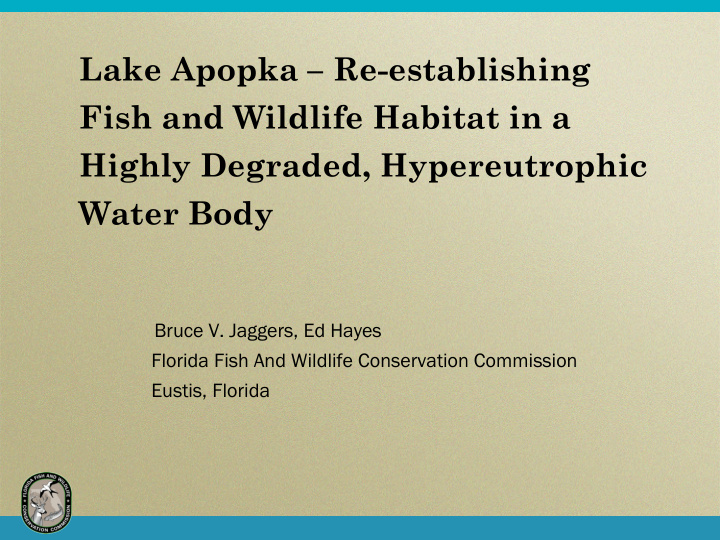



Lake Apopka – Re-establishing Fish and Wildlife Habitat in a Highly Degraded, Hypereutrophic Water Body Bruce V. Jaggers, Ed Hayes Florida Fish And Wildlife Conservation Commission Eustis, Florida
Goal Current Condition - Less than 1% aquatic vegetation in lake portion of Apopka. Goal – Re-establish 10% aquatic vegetation in Lake Apopka in 10 years (Tiger Team).
Challenges Poor light penetration – secchi typically 1 foot or less. Large deposits of flocculent mud. Limited littoral areas – 20,000 acres of marshes cut off from lake by levees. Functions as a Reservoir – 5 feet of water 50 feet from levees at minimum desirable lake level. Extreme wind fetches – Over 10 miles in distance across the lake.
North Shore Marshes – 20,000 Acres
Opportunities Lake Levels 2 feet below low pool (opportunity to establish plants in ~3 feet of water). Suitable substrates for planting (firm peat deposits).
Decision Point Focus on planting spatterdock ( Nuphar spp.) and giant bulrush ( Schoenoplectus californicus ). Native aquatic species able to establish and survive in deeper water. Establish submersed plants (SAV) behind “wave breaks” created by initial plantings.
Planting Scheme
Spatterdock Planting Zones Spatterdock Spatterdock
Questions What methods do we use for large-scale spatterdock plantings? Has this been done before? Will plants survive and establish in Apopka?
Evaluated Techniques (2012) Bare root plants (small rhizomes). Wild harvest plants (large rhizomes). Nursery grown plants (UF greenhouse).
Decision Point Focus on planting wild harvest and nursery grow-out plants (2013 & 2014). Best outcome considering plant survival, logistics and cost.
Spring/Summer/Fall 2013 Planted 25,000 wild harvested spatterdock. Planted 10,000 nursery grow-out spatterdock. Planted 500 UF greenhouse spatterdock. Laughlin Road Site
Spring/2014 Planted 50,000 wild harvested spatterdock. Planted 10,000 nursery grow-out spatterdock. Planted 300 UF greenhouse spatterdock.
Spatterdock Survival Estimates Wild harvest ~60% survival. Nursery grow-out ~75% survival. UF greenhouse grow-out ~80% survival. Total # spatterdock plants installed – 96,000
Costs to Plant Spatterdock Wild harvest - $2.58/plant. Nursery grow-out - $6.80/plant. UF greenhouse grow-out - ~$27.80/plant. Total Spent (as of May 2014) - $327,753
Progress Toward 10% Goal (as of May 2014) ~450 acres aquatic plants (1.5% of lake) Next step – test plots of SAV planted in protected spots behind emergent plants
Spatterdock Wild Harvest Plants Laughlin Road Site
Wild Harvest Methods
Nursery Methods – Pond Grow-out
Nursery Methods – UF Greenhouse
Question Why the difference in survival between wild harvest plots? E.g. 30 – 85% survival in individual plots. Substrate conditions and water levels appeared to be similar between 7 plots.
Keys To Successful Plantings Large rhizomes (wild harvest plants or plants grown out in nursery). Current low water levels (below regulation schedule). Sites with suitable substrates available. Nutrients available for good plant growth.
Constraints To Successful Plantings Deep water (even at water levels below regulation schedule). Poor light penetration. Wind/wave energy generated on large lake (initial plantings have survived winter storms so far). Availability of plant material to transplant. Long transport distances.
Wild Cards Water Levels/Water Storage (water levels in planting zones 6 feet at upper end of regulation schedule). Wind/wave energy generated on a 30,000 acre water body (initial plantings have survived winter and summer storms so far). Tropical storm after 1970’s effort! Toxicity of some sediments?
High Sediment Sulphides Concentrations Causing Plant Damage?
QUESTIONS?
Recommend
More recommend